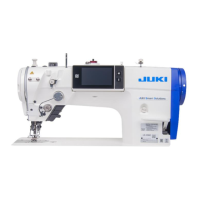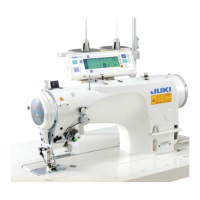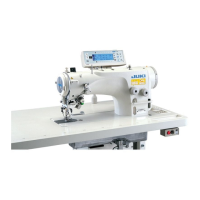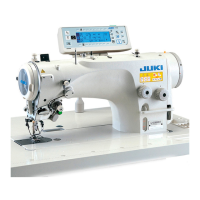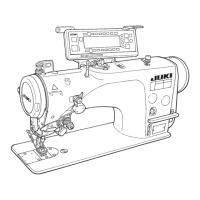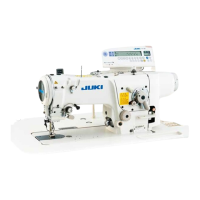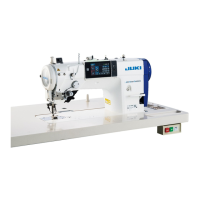
Do you have a question about the JUKI LZ-2290C-F and is the answer not in the manual?
| Model | LZ-2290C-F |
|---|---|
| Stitch Type | Zigzag |
| Max Stitch Length | 5 mm |
| Needle Bar Stroke | 30.7 mm |
| Max Zigzag Width | 10 mm |
| Feed Dog | 3-row |
| Lubrication | Automatic |
| Motor Power | 550 W |
| Sewing Speed | 5, 000 stitches per minute |
| Needle | DPx5 |
| Hook | Rotary hook |
| Thread | Synthetic thread |
| Motor Type | Servo motor |
| Type | Electronic Zigzag Lockstitch Sewing Machine |
Details and technical specifications for the sewing machine head unit.
Technical specifications for the control box, including voltage and environment.
Diagram showing table dimensions and hole placements for setup.
Safety and handling precautions for machine setup, including carrying and placing.
Steps for installing the sewing machine head onto the table securely.
Procedure for removing the needle bar stopper for transportation and storage.
How to attach the knee-lifter mechanism to the sewing machine.
Adjusting the lift height of the presser foot using the knee lifter.
Steps for assembling and installing the thread stand unit.
How to install the thread guide pin on the machine head.
Procedures for installing the electrical control box on the machine.
Steps for installing the reactor box, specific to EU models.
How to connect the power switch cable to the machine.
Reference to a manual for installing the accessory ring core.
Safety precautions and steps for connecting internal and external cords.
Instructions for managing and securing power and internal cords safely.
Steps for attaching the connecting rod to the pedal lever.
Adjusting the pedal tilt and connecting rod length.
Explanation of how to operate the sewing machine using the foot pedal.
Procedure for filling and maintaining the oil tank and hook lubrication.
Basic guide to navigating the operation panel, including language and clock settings.
Adjusting needle and bobbin thread tension for optimal stitch quality.
Adjusting the stroke and pressure of the thread take-up spring.
Adjusting presser foot pressure via the operation panel.
How to adjust the stitch length using the operation panel.
Procedure for adjusting the sewing machine's speed.
Information on the LED hand light feature and its intensity adjustment.
Explanation of the reverse feed stitching function.
How to assign functions to the custom switches.
Using the mirror stitching function for inverted patterns.
Instructions for performing fagot stitch sewing.
Procedure for adjusting the oil amount in the hook mechanism.
Overview of the sewing screen display and controls in different modes.
Covers selecting, configuring, listing, editing, and managing sewing patterns.
Instructions for setting various sewing shapes like zigzag, scallop, and blind stitch.
Adjusting feed dog height, timing, and locus for different materials.
Using counters for tracking stitches, time, or bobbin thread.
A visual map of the operation panel's screen flow.
Reference table for memory switch settings and their functions.
Troubleshooting guide for common error codes and their causes.
How to view and edit memory switch data for machine customization.
Instructions for cleaning the cooling fan and hook section.
Guidance on applying grease to the machine's moving parts.
Steps for safely replacing the machine's fuses.
Information on proper battery disposal following regulations.
Procedure for adjusting hook timing and needle bar position.
How to adjust the needle bar height for proper stitch formation.
Fine-tuning needle-to-hook timing and setting the needle guard.
Steps for replacing the sewing hook assembly.
How to adjust the initial position and timing of the thread trimmer.
Adjusting the needle thread feeding device for proper tension.
Adjusting the feed dog's height and angle for correct fabric feeding.
Setting up the function to detect multi-layered material sections.
Procedures for creating, copying, and deleting sewing patterns.
How to edit and set up polygonal-shape stitching patterns.
How to select, edit, and create continuous sewing patterns.
Procedures for selecting, editing, and creating cycle sewing patterns.
Creating, selecting, editing, copying, and deleting custom stitch patterns.
Setting up and editing condensation custom patterns.
Activating the screen lock to prevent accidental operations.
Displaying software and communication version information.
How to adjust the brightness of the operation panel's LED display.
Covers data communication, USB, and NFC transfer methods.
Assigning functions to panel keys for customized operation.
Setting up warnings and managing maintenance intervals based on counts.
